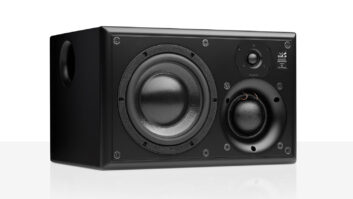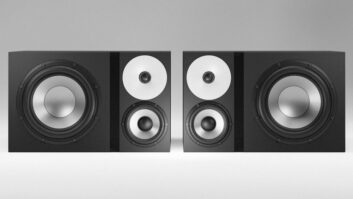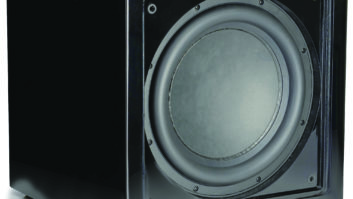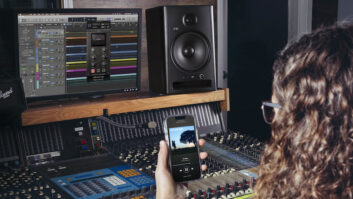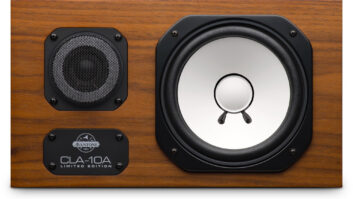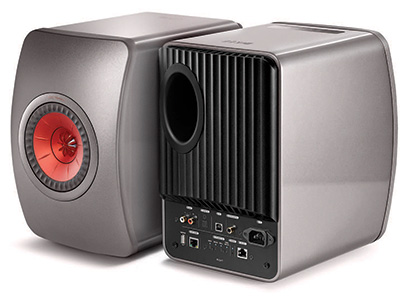
KEF isa multinational company that makes architectural speakers,headphones,home theater, hi-fi and “digital solutions,” the category where the LS50W Wireless monitorsreside. Although I’d neverheardof KEF,onceIgot the units in forreview, manyof my colleagues atBlackbirdStudio inNashvillenotonly knewof them, but citedseveral longtime Nashville engineers who use and love the company’s speakers.
Thedual,bi-amped enclosures (30W class A/B for the tweeter and 200W classD for the mid/bass) feature the company’s Uni-Q driver—a 5.25-inch woofer witha 1-inch tweeter floating in thecenter (aka coaxial, though a variation). The benefitsof thisdesign are the consistent, phase-correct deliveryof low- and high-frequency material to the listener and thereal estate gained bynot having separated drivers in the box.
The LS50W Wireless monitors debuted inOctober 2016 and come inGloss White witha copper driver,Gloss Black witha Blue driver, andTitanium withaRed driver. The word wireless in the title isa bit misleading in that you can use them thatway, but there are plenty of input options that cover all the bases.I used them in tracking and overdubsessions invarious rooms at Blackbird and in my home.
KEF unabashedly calls the LS-50Ws an audiophile speaker. This sends up redflags for some engineers, but that’s anargument foranother day with plenty of drinks. I’ve had my most moving listening experiences on audiophile systems, so to me it’s justanother product description.
The IEC power socket and all the I/O areon thedesignated right monitor and includes: Optical (Toslink), USB typeB (labeled PC), female USB typeA for systemupgrades,EthernetNetwork input, a dedicated Ethernet output to the left speaker, RCA L/R inputs, and an RCA subwoofer output. There are smallpush-button EQ adjustments for Desk or Stand mount, andproximity adjustments for Wallor FreeSpace, as well asa deep-set Resetbutton forreturning everything to its factory setting. Themonitors are also capableof Wi-Fi andBluetooth operation. At the topof the speaker are soft-touch switches for turning them on, and toggling between thefive input modes— Wi-Fi,Bluetooth, Aux (RCA), Optical and PC (USB).
The left speakercarries an IEC,a manual balance knob, and the Ethernet input used to bring audio to the speaker. The enclosures are solidly built, and thefit,finish and color options are beautiful. KEF uses “constrainedlayer damping bracing”inside the box, witha precision-made curved baffle and elliptical, flexible sound port to re- duce turbulence and chuffing. Theinternal tech continues with an end-to-end 192kHz/24-bit high-resolution digital signal path using two dedicated DACs per channel (four total). The digital conversion first happens as soon as the signal arrivesin the right speaker then moves to the left through the Ethernet connector. A second DAC is used post-crossoverin each enclosure, allowinga more granular decode and control of the signal after DSP. Each driveris treated as a separate entityin the analog phase of the output for better quality.
For control, thereisa battery-powered remote and an app, whichis where Bluetooth and Wi-Fi enter the picture. BeforeI even heard the monitors, I downloaded the app from the Google Play store and connected my phone, Blackbird’s Wi-Fi network and the speakers. The procedure is standard fare, the same way you would set upa wireless thermostat, fan or other consumer device.Once it’s done, youcan use the app to varya number of great features.
At the bottomof the app’smenu screen, the Settings tab takes you to a second page, where you can send feedback,go to KEF’s website, etc., or to MySpeakers. This is where you can add another setof LS50Wsor go to your system for tweaking (thisonly works if your speakers areon and set to Wi-Fi). Thefirst stop underSpeaker Sound Settings isamore consumer-oriented page where youdesignatehow your speakers are set up (standordesk),how close they are to the back wall,how large your room is inmeters, and whethera sub isplugged in.
However,pros wanting moreprecision aregoing to want to choose the Expert page. Here, there are choices for engaging Desk and Wall Mode—unlike the app’s consumer sectionyou can peel back the Wall mode (at 220 Hz)up to -6dBof attenuation in 0.5dB increments. There is alsoa treble trim where you can boost/cut the top end ±2dB.Next isa phase correction switch that “removesphase incoherence/time smear- ing causedby the crossover, allowing the LS50W to achieveanearly 0-degree phase shift between crossoverfilteroutputs.” If this is true, which I’m sure it is, it should beon all the time. There are choices for Bass Extension, Less,Standard or Extra.I leftmy system inStandard mode at all times and they worked perfectly across allmy applications.
The settings grouped at the bottom of the app are all about the sub. You can set the High Pass frequency anywhere between 50 Hz and 120 Hz, set the suboutputs LP frequency anywhere between 40 Hz and 250 Hz, adjust the sub’s gainplusor minus 10 dBof 0, andflip the sub’s polarity. The app isa tweaker’s paradise that you can toggle right from the listening position. Theonlydownside is that the speakersneed to be in Wi-Fimode to use the app, meaning you can’t A/B settings immediately. This, and the lackof balanced inputs, is where the LS50s would gain froma Pro Audio version that incorporated these features.
INTO THE STUDIO
Afterabreak-in periodof manyhours,myfirst listen wason anoverdub session inBlackbird’s iconicStudio C.I set everythingflat, turned off the Desk and Wallmodes, andgot to work. If anything, the bottom end wasabit tooround, soI tempered thatbyputting themonitors back in Wallmode and attenuating the bottom enda dBor 2—perfect. My kick drum, popof the snare andoverheads, silky top end, andpunchy mid-range sounded exactly as they did in the trackingroom whereImonitoredon an ATC soffit-mounted system and Genelec 1031s.
Theoverdubs were guitars and percussion, which also sounded fan- tastic—plentyof smooth topon tambourine and shakers, andpunchy, cutting midsona guitar amprecorded witha Royer 121 andSM57. When I added EQ using the channelon the SSL 9K, it sounded asIremembered onother sessions. It wasa treat learning to trust the LS50Ws.I always havea timegetting used to the auto-shutoff that some systems have.
The KEFs shut down after about 15 minutes, and you have to tap the controls at the top tofire themup again.A minor inconvenience youget used to in the studio. Next,I took them in to Blackbird ’s StudioE on top of an API 1608 whereI found the firstflaw.I was usinga short XLR-to-RCA turnaround to get from theconsole to theKEFs, but in this room there was noticeable 60-cycle hum from the LS-50Ws when my large and alternate near-field monitors were chosen. This went away when the KEFs were the main speaker.
I tried ground lifting theAC plugs and even swapped to new XLR to RCA translators, but it didn’t help. Being thatI didn’t run into this in two other rooms,I figured it wasa problem between the API and the LS50W’s unbalanced inputs not playing nicely together.
During the session, it wasrevealing asI quickly switched between ATC SCM50As and the LS50Ws—the jump was surprisingly compara- ble. Of course the largermonitors hadmore bottom end,but theoverall balanceof frequencies, smoothnessof mids and highs, andoverall sonic presence in theroom was so similar that itgotreactions throughout the room asI switched between them.
I startedusing the KEFson every sessionovera two-week period all with greatresults and then took them home to seehow they fared in less thanprofessional environments.I sent the LS50Ws audiooptically frommy TV and set the systemuponmy Wi-Finetwork. They sounded fantastic.I streamedmovies fromNetflix and Amazon,played Apple Lossless songsover theBluetooth connection frommyphone, jumping between the two setups with theremote. It’sa beautiful high-end sys- tem for thehome, where the bountiful I/O,remote control with app, and wirelessoptionsfit perfectly.
Where could they benefit? Apart from adding balanced inputs and the ability to immediately A/B using the app, I’d like to seededicated Mode switcheson theremote itself. Inother words, insteadof toggling blindly through thefivemonitoringmodes with anup anddown switch, it would be better to be able to jump from Optical to Wi-Fi,orother nonconsecutive settings directly withabutton. Forhome useI would love to be able to havefive LS50Wsplaying backa Dolby stream frommy Amazon Fireor Apple TV,but multichanneldecoding isnot supported, nor is Dante, which would be interesting. These added features would of course drive up theprice,but the connectors are already there and it’s nota leap to think there would be interest.
The KEF LS50Wsbreaka lotofnew ground ina unique way. First, the sound and features-to-price ratio is unheardof—they are a true bargain. They are compact, yet the bottom end isbigger andmore trustworthy than you would ever believe. If setup correctly, I’dnothesitate to make confident low end decisions—evenwithout a sub! There isplenty of booty. And although there isroom for improvement, theremote controllability is excellent. Rather than having justpreset EQ functions, you can trim the levels tofine-tune your experience.
Finally, the LS50Ws sound great. It’s luxury listening in the studio and athome. So if you have themoney in yourbudget and you’re looking fora portable, truthfulmonitor, you have to give the KEF LS50Wsa listen. You won’t be disappointed.
Product Summary
COMPANY: KEF
WEBSITE:KEF.com
PRICE: $2,199.99 (a pair)
PROS: Compact, great-sounding monitors. App control and wireless remote, abundant inputs.
CONS:Remote switching requires Wi-Fi mode, no balanced inputs.
